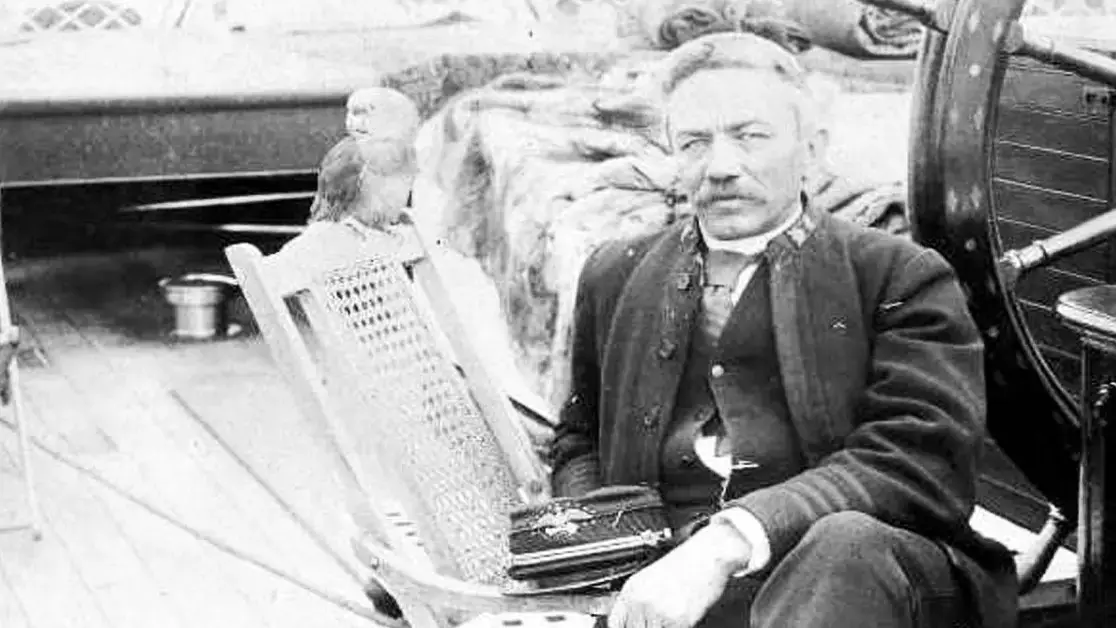This is the official history of the Coast Guard’s ‘Hell Roarin’ legend

SUMMARY
Captain Michael "Hell Roarin'" Healy, known for bringing the reindeer to Alaska, had another claim to fame in the U.S. Revenue Cutter Service, forerunner to the modern-day Coast Guard.
Healy had a no-nonsense, often violent, style of command. Rumors spread that he had unruly people hung by their hands or feet in the hull of the ship. (And he weathered a couple of failed mutinies as a result.) When dealing with those who tried to block what he felt was the protection of the native people of Alaska, he could turn violent and belligerent until he got what he wanted. He stood for law and order along the 30,000 mile long Alaskan coast.
After multiple courts martial for drunk and disorderly conduct in the late 1890s, Healy was sent to a trial board for abusive conduct towards junior officers while intoxicated. While the trial board recommended him for discharge, Secretary of the Treasury John Carlisle instead removed him from command and placed him on shore duty for four years. Healy was also publicly humiliated by having his punishment read to every commissioned officer on every cutter in the service.
Healy was back on dry land for the first time after nearly 42 years at sea.
This punishment furthered Healy's paranoia that "they" had been working to drive him out of the service, which he first expressed as early as 1893. While some officers thought this was the beginning of the end of Healy, they were wrong. The Healy family believed their lives could not be ruined any further. They did not know the true tragedy that would come.
At the end of his four year punishment, Healy's life would take an ironic and drastic turn. Capt. W.C. Coulson, who had sat on the trial board and recommended his discharge, asked for Healy by name to replace him as the commanding officer of the Revenue Steamer McCulloch when his wife fell ill. While he served aboard the McCulloch, Healy received orders to serve upon the Cutter Seminole out of Boston. After more than twenty years on the west coast and nearly a decade in Alaska, he saw the transfer as another punishment because his wife had made her home in the west and his son, now grown, had started his own family there.
When he received these orders, his mental health took a turn for the worst. He was found sitting outside of the stateroom of a passenger on the McCulloch, yelling and threatening to kill himself. The following day, Healy attempted to throw himself overboard, stopped only after being violently wrestled to the deck by Second Assistant Engineer J.J. Bryan. At that point, executive officer 1st Lt. P.W. Thompson brought Healy to the ward room and informed him that he was longer in command of the McCulloch.
Healy was to be guarded in his cabin until Thompson was able to contact the Treasury. On the morning of July 10, 1900, Healy again attempted to throw himself overboard. While he was out of his bunk, he grabbed a piece of glass, and two days later almost succeeded in using it to kill himself. One onlooker offered an explanation for the suicide attempts as a cry for help as Healy was just returned to the ship after a drunken night out and would again be court-marshaled and kicked out of the service.
In 1903, Healy quietly exited the service at the mandatory retirement age and died a year later of a heart attack. He was buried in Colma, California, where he and his family finally settled.
Healy carried secrets with him that could never be uttered in early-twentieth century America. His wife, Mary Jane Roach, was a second generation Irish immigrant but despite eighteen pregnancies, they only had one child. He was constantly criticized for being Catholic, something that was still looked down upon at the turn of the century. In addition, Healy was the child of Michael Morris Healy, an Irish immigrant and slave owner and his slave, Mary Eliza Smith. This was kept a secret even from parts of his family. After his death, Healy's daughter-in-law destroyed his four-volume diary. She was contacted by a film studio on the possibility of a movie based on his life and they wanted to see his diary in the writing of the film. As she read the diary for the first time, she discovered her husband's grandmother was a slave.
Today, Healy is known as one of the great giants of Coast Guard history. He singlehandedly saved large groups of natives from starvation, and his courage was unmatched by anyone else at the time. History was kind to him and glossed over his negative personal record in favor of his accomplishments. In honor of his legacy of arctic service, the Coast Guard's newest ice breaker was named in his honor in 1997.
SHARE
